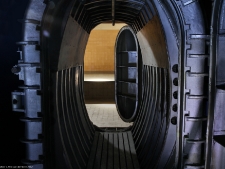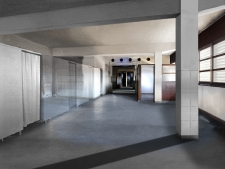The sanitary station is both a place steeped in history – that of a city at the heart of the fight against epidemics – and a high-quality architectural achievement, thought of as a functional response to the question of health control, at the when it takes a new turn. Heiress to the lazarettos of the 18th and 19th centuries, it allowed the disinfection of passengers arriving by sea and air, the detection of doubtful cases and the care of the sick. This site, abandoned for more than forty years and having come close to destruction in 2009, has been transformed into the Regards de Provence Museum thanks to private investment from the Regards de Provence Foundation.
In the center of the building, the room of the ovens preserved in the rehabilitation, directly accessible from the entrance to the Museum, is a medium-sized space with an evocative and spectacular facade of autoclaves and machinery.
The exhibition, integrating this complex of ovens, is highlighted through a strong three-dimensional scenography designed by the artists, Dominik Barbier and Anne Van den Steen (duration 45 min). The staging of the exhibition exploits, among other things, strong images of the ancient and contemporary plastic worlds, such as reproductions of works by Peter Brueghel, Michel Serres or John Craven’s photos on the station. She uses videos, electronic scenography, special effects of sound, light and water, illustrating the symbolic themes of “The arrival by boat in Marseille”; of “Marseille and health control”; “Showers”; and “Apotheosis”. Artistic and Historical Documentary included in the entrance ticket to the exhibitions.
Open Tuesday to Sunday, 10 a.m. to 6 p.m.
This permanent artistic documentary is supported by the City of Marseille, the Crédit Agricole Alpes Provence Corporate Foundation and the Grand Port Maritime de Marseille.





